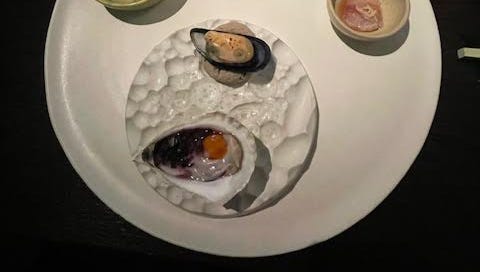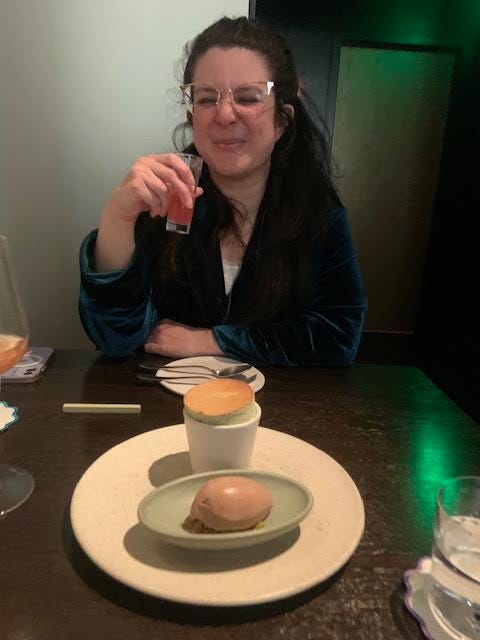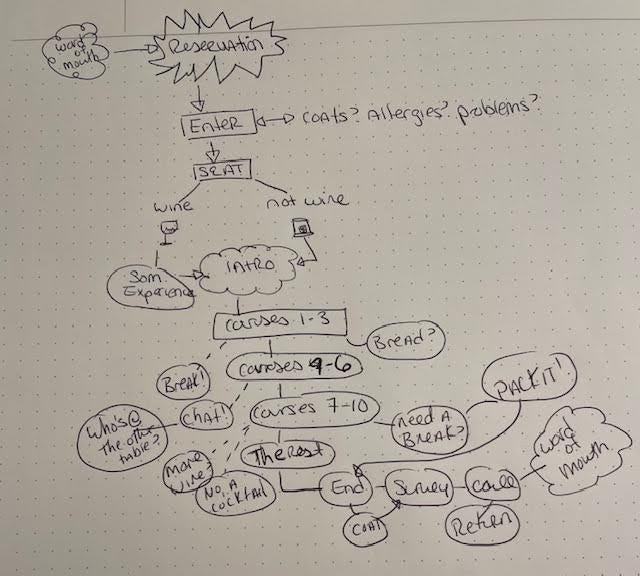A few weeks ago I lost my mind completely and made a last-minute dinner reservation for a fancy restaurant. Not simply any restaurant, but a Michelin-grade 25-seat, 20-course dining experience in a row home where you watch them cook.
If you’ve never been to one of these dinners, let me tell you about it.
Before you even arrive, you will receive messages confirming your seating and any special requests. From the moment you cross the threshold, you are paid attention to. You’re escorted to your seat and asked questions. They might take your coat and bring it to some far off room, from which it will return smelling better than before.. They might ask you about your day, how far you traveled, or try to prepare you for the encounter ahead. You walk to a private seating area with only two tables and minimalist decor of shapes. The amorphous beige shapes of the decor calm your nerves and reduce your cortisol for the meal incoming (I imagine, I don’t know, I write about sandwiches).
While settling in you receive the menu, which is truly a list of what you will be eating. There is no choosing at a restaurant like this. The chef has crafted a show for you. Water choices are discussed, drink choices are discussed, and finally dietary restrictions, which you are likely to have gone over already, too. Items are removed from the table to clear a path. A sommelier will come out and explain your wine to you, swishing it around, pouring it and then staring at you. Pucker your lips and say MMM MHMM. You already know it’s going to be good, because they chose it and they know what they’re doing.
Now the great foreplay has concluded and the first course comes out. You’re so happy to see it that it doesn’t matter if it’s really tiny, you gobble it up anyway. It’s usually something really beautiful and small in a round bowl with an edible flower and you spend 10 minutes taking a photo and consume it in one bite. The second course is equally small and you take 10 photos and then you consume that in one bite. Course three is small and you take 10 photos and you eat it. Now, by the time the fourth course comes, and particularly in the time while you wait for your plate to be cleared, crumbs to be scraped away and the next dish to be placed in front of you, you start to get really hungry. It’s at this moment that bread or some other extra might be placed in front of you.
By plate six a delirium begins to set in where you forget what you’re eating but you fully trust the staff and gobble down anything they set down on the table, tiny bowls, tiny plates everywhere, flowing freely, one after the other. Ingredients are mentioned (I don't know, I write about karaoke). One course will have a little spoon cup you pour or perhaps a crème you drizzle or some kind of sprinkling mechanism. It’s interactive and you feel like you, too, are a chef at the fancy restaurant. Between courses, when your defenses are down, wine, water and cocktails are constantly being replenished. Your needs are being anticipated and you are never in want. There may be an interlude from a chef who will explain the origins of the leaves on your plate, but otherwise your senses are leading.
You’re eating for hours. Time slows down, there are no windows, somewhere a clock ticks and like in a casino you make big bets about being able to finish everything and the dessert. And finally, it’s done. You can’t believe you have to leave. You’ve made family with these people, but just like that, you exit. Possibly that night, but more likely the next day or the next week, you might get an email from the restaurant for feedback. They actually want to know and they will reply if you leave questions.
This meal is a story. You enter with an idea of what you’re about to experience, but course by course, taste by taste, you are drawn further into episodes. Your assumptions are challenged (maybe you thought you didn’t like salmon, but as part of a pretty little bowl with other ingredients, you love it). You learn things you didn’t know, and expand your flavor profile. You meet new people, maybe you lean toward the table next to you and see what they think. Little by little you’ve composed a complete book of the evening. If I had to lay out the user journey of the evening, it might go like this:
You can see that despite a few diversions or customizations that enhance the stage you're at, there is one set of actions to go deep with. There’s a flow to the evening that makes sense and it usually ends in wanting to return.
Now, what of news and information? We start in a very different place than the $400 dinner. Our information systems are nothing like our hospitality systems, but what if we pretended they were? What if we imagined that they were built off the same ideal: to make people feel welcome and ensure that they tell others to stop by?
First of all, Whether you heard of us from a friend may be irrelevant if you “enter” through a search engine or are served a paid ad. Data has shown that receiving a link from someone you trust enhances the chances that you will interact with it. That could look like a gift link, a free trial, or a gift trial.
Upon entrance, an introduction. How do we expect readers to know what’s behind the paywall, or even behind another click, without some kind of welcome mat that explains what they’re in for as they progress down the site?
A choice between wine pairings and not is more than a beverage decision, it changes your payscale, it can change the palette of the dinner, or it can change the tone of the night. Imagine an opportunity to pick your experience on a news site. Drive long distances and prefer mostly audio? Or you need a synopsis sent to you in the evenings because you don’t have a lot of time. Perhaps you want a cleaner experience and are willing to pay more. Or you want a spicier experience and prefer all Opinion content for lively discussion.
Imagine our courses as articles. Between each course there is a palette cleanser that changes depending on where you are in your meal: a conversation, a break, a piece of bread, a drink refill. Those small stops in flow change how you experience the next course, how receptive you are, how excited you are and how prepared with knowledge you might be. What are the design or contextual cues we can offer our audience to help them feel similar? A thesaurus? A survey? A timeline before they move on? A progress bar?
Many websites have a signup popup upon exist but that email address goes directly into a careless marketing funnel that abuses inboxes. The more our inbox is used for trash, the less likely we are to notice when something important sits in it. We hear from these fine dining experiences at strategic times, less often and with more importance - and it shows. How can we lighten our touch on how many marketing emails are sent, or give people the choice of how and when to receive information. “But they click on it!” Maybe. But is it worth the long term loss of trust to trick someone into a cheap tactic?
If we think of our news products as restaurants, the main metric we focus on is care, and that changes the goal conversation considerably. We start to really think about where people enter from and how we can continue that loop by making it easier to share or be a first-time visitor. We consider the context from “course” to “course,” learning how they interact and enhance each other, rather than individual pieces click-to-click. We take them on a journey of information, rather than crossing our fingers and hoping they’ll click again; most news readers do not. If a pleasing experience becomes the major mission, the path to get there looks very different. And while I cut many of my news subscriptions when I lost my job, I willingly threw down a couple hundred bucks to be welcomed and feel tactile bliss for a few hours one spring night.
Am I off base here? Next week - Epic Universe.
Goodnight, Commenters.






